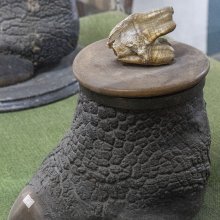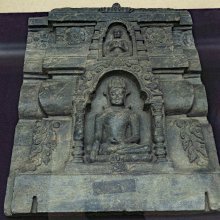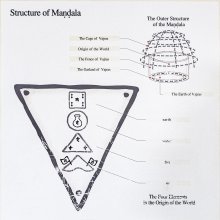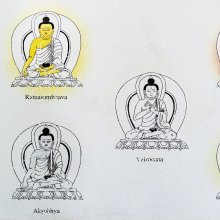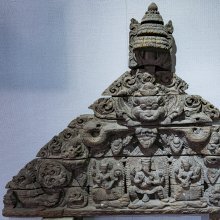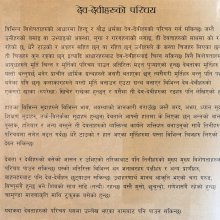Mathi, Māṭhī, Māthi: 10 definitions
Introduction:
Mathi means something in Hinduism, Sanskrit, Buddhism, Pali, Marathi, biology. If you want to know the exact meaning, history, etymology or English translation of this term then check out the descriptions on this page. Add your comment or reference to a book if you want to contribute to this summary article.
Images (photo gallery)
(+1 more images available)
Biology (plants and animals)
Source: Google Books: CRC World Dictionary (Regional names)1) Mathi in India is the name of a plant defined with Terminalia crenulata in various botanical sources. This page contains potential references in Ayurveda, modern medicine, and other folk traditions or local practices It has the synonym Pentaptera crenulata (Roth) DC..
2) Mathi is also identified with Trigonella foenum-graecum It has the synonym Medicago tibetana (Alef.) Vassilcz. (etc.).
Example references for further research on medicinal uses or toxicity (see latin names for full list):
· Grassland of China (1997)
· Journal of Ethnopharmacology (2003)
· Journal of Ethnopharmacology (2002)
· Journal of Ethnopharmacology (2006)
· Acta Inst. Bot. Acad. Sci. URSS (1953)
· Cytologia (1988)
If you are looking for specific details regarding Mathi, for example chemical composition, health benefits, extract dosage, side effects, diet and recipes, pregnancy safety, have a look at these references.

This sections includes definitions from the five kingdoms of living things: Animals, Plants, Fungi, Protists and Monera. It will include both the official binomial nomenclature (scientific names usually in Latin) as well as regional spellings and variants.
Languages of India and abroad
Pali-English dictionary
Source: BuddhaSasana: Concise Pali-English Dictionarymathi : (aor. of mathati) shook about; churned; disturbed.
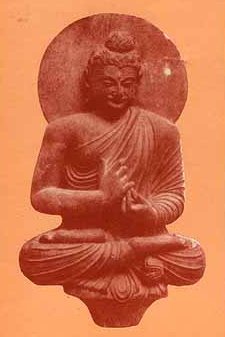
Pali is the language of the Tipiṭaka, which is the sacred canon of Theravāda Buddhism and contains much of the Buddha’s speech. Closeley related to Sanskrit, both languages are used interchangeably between religions.
Marathi-English dictionary
Source: DDSA: The Aryabhusan school dictionary, Marathi-Englishmaṭhī (मठी).—f A small maṭha; a hermitage.
Marathi is an Indo-European language having over 70 million native speakers people in (predominantly) Maharashtra India. Marathi, like many other Indo-Aryan languages, evolved from early forms of Prakrit, which itself is a subset of Sanskrit, one of the most ancient languages of the world.
Sanskrit dictionary
Source: DDSA: The practical Sanskrit-English dictionaryMathi (मथि).—[math i] A churning-stick.
Derivable forms: mathiḥ (मथिः).
--- OR ---
Māṭhī (माठी).—An armour, mail.
See also (synonyms): māṭi.
Source: Cologne Digital Sanskrit Dictionaries: Shabda-Sagara Sanskrit-English DictionaryMaṭhī (मठी).—f. (-ṭhī) A cell. 2. A cloister.
Source: Cologne Digital Sanskrit Dictionaries: Monier-Williams Sanskrit-English Dictionary1) Mathi (मथि):—[from manth] (ifc.; cf. [Pāṇini 3-2, 27]) See urā-, vastraand havir-mathi (mathīnān, [Ṛg-veda viii, 53, 8 [probably]] [wrong reading] for matīnām; cf. mathin).
2) Māṭhī (माठी):—f. armour, mail, [cf. Lexicographers, esp. such as amarasiṃha, halāyudha, hemacandra, etc.] (cf. māṭi).
Source: DDSA: Paia-sadda-mahannavo; a comprehensive Prakrit Hindi dictionary (S)Māṭhī (माठी) in the Sanskrit language is related to the Prakrit word: Māḍhī.
[Sanskrit to German]
Sanskrit, also spelled संस्कृतम् (saṃskṛtam), is an ancient language of India commonly seen as the grandmother of the Indo-European language family (even English!). Closely allied with Prakrit and Pali, Sanskrit is more exhaustive in both grammar and terms and has the most extensive collection of literature in the world, greatly surpassing its sister-languages Greek and Latin.
Kannada-English dictionary
Source: Alar: Kannada-English corpusMaṭhi (ಮಠಿ):—[noun] the grass Saccharum sara ( = S. munja) of Poaceae family.
--- OR ---
Mathi (ಮಥಿ):—[noun] a stick with a disc-like part, with zig-zag teeth, at one end for churning curd; a churning stick.
Kannada is a Dravidian language (as opposed to the Indo-European language family) mainly spoken in the southwestern region of India.
See also (Relevant definitions)
Starts with (+153): Mathiari, Mathibaji, Mathibathibane, Mathika, Mathiko-deuta, Mathilkkoorka, Mathilkkurka, Mathilla, Mathillo, Mathillo-tala, Mathilppati, Mathimgala, Mathimva, Mathin, Mathina, Mathirimangalam, Mathirishi, Mathisu, Mathit, Mathita.
Ends with (+78): A-campirannatacamati, Acammati, Amati, Ankaramati, Anticamati, Anumati, Arasina ummathi, Armati, Belimathi, Camati, Camatti, Cammati, Campirannatacamati, Cantiramati, Catturu-namati, Cavikarpacamati, Cemati, Chiramathi, Cimati, Cinmati.
Full-text (+93): Kashthamathi, Mathin, Madhi, Math, Atha, Apirekku, Kalamati, Matiketu, Matiyani, Cirankaccampa, Cimmatu, Kettavari, Metuvatai, Kaimatiyam, Matikanti, Matilavanam, Unmantha, Jalaputpam, Arukanti, Kakipellam.
Relevant text
Search found 5 books and stories containing Mathi, Maṭhī, Māṭhī, Maṭhi, Māthi; (plurals include: Mathis, Maṭhīs, Māṭhīs, Maṭhis, Māthis). You can also click to the full overview containing English textual excerpts. Below are direct links for the most relevant articles:
Rig Veda (translation and commentary) (by H. H. Wilson)
Rig Veda 4.38.5 < [Sukta 38]
Jnaneshwari (Bhavartha Dipika) (by Ramchandra Keshav Bhagwat)
Verse 18.53 < [Chapter 18 - Moksha-sannyasa-yoga]
Ramcharitmanas of Tulsidas < [October – December, 2003]
Natyashastra (English) (by Bharata-muni)
Folk Tales of Gujarat (and Jhaverchand Meghani) (by Vandana P. Soni)
